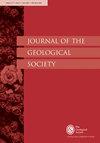特提斯-喜马拉雅中白垩世红层的古地磁:方向差异及其构造意义
IF 3
3区 地球科学
Q2 GEOSCIENCES, MULTIDISCIPLINARY
引用次数: 0
摘要
了解大印度的北部延伸对于模拟印度-亚洲碰撞过程和青藏高原的形成至关重要。本文介绍了特提斯喜马拉雅地区中白垩世(约106 Ma)嘉布拉组红层的新古地磁资料。从19个位点分离出明确的高实验室解封温度组分磁化,并通过了折叠测试,表明它们是预折叠磁化。倾斜校正后的位置-平均方向为D s = 222.9°,I s = +39.4°,α 95 = 4.2°。经各向异性倾角浅化校正后,井位平均倾角由39.4°增加到45.8°。赤纬和倾角与邻近的剖面有很大的不同。这种红色层的方向性差异可能是由于采样剖面(zb1 - 11,40 - 52)被翻转和局部垂直轴旋转所致。结合新的古地磁资料和已有的古地磁资料,特提斯喜马拉雅位于27.5°±2.4°S。我们的新结果,结合从特提斯喜马拉雅地区获得的可靠的白垩纪古地磁数据,以及从印度克拉通获得的同时期古纬度,支持了一个较小的大印度,并且特提斯喜马拉雅地区在白垩纪中期没有从印度克拉通断裂。专题文集:本文是中生代和新生代构造、景观和气候变化文集的一部分,可在:https://www.lyellcollection.org/topic/collections/mesozoic-and-cenozoic-tectonics-landscape-and-climate-change获取补充资料:https://doi.org/10.6084/m9.figshare.c.6795683本文章由计算机程序翻译,如有差异,请以英文原文为准。
Palaeomagnetism of the mid-Cretaceous red beds from the Tethyan Himalaya: direction discrepancy and tectonic implications
Understanding the northern extension of Greater India is vital for modeling the India-Asia collision process and the formation of the Tibetan Plateau. We present new palaeomagnetic data from the mid-Cretaceous (ca. 106 Ma) Gyabula Formation red beds in the Tethyan Himalaya. Well-defined high laboratory unblocking temperature component magnetizations were isolated from 19 sites and pass the fold tests, indicating that they are pre-folding magnetizations. The tilt-corrected site-mean direction is D
s
= 222.9°, I
s
= +39.4° with
α
95
= 4.2°. The site-mean inclination increases from 39.4° to 45.8° after anisotropy-based inclination shallowing correction. The declination and inclination differ considerably from those of neighboring sections. This directional discrepancy of the red beds may be attributed to the fact that the sampled section (sites ZB1–11, 40–52) is overturned and local vertical axis rotation. The combination of our new and previously published palaeomagnetic data shows that the Tethyan Himalaya was located at 27.5° ± 2.4°S for the sampled area. Our new results, together with the reliable Cretaceous palaeomagnetic data obtained from the Tethyan Himalaya as well as coeval palaeolatitudes expected from the Indian craton, support a smaller Greater India and that the Tethyan Himalaya did not rift from the Indian craton during the mid-Cretaceous.
Thematic collection:
This article is part of the Mesozoic and Cenozoic tectonics, landscape and climate change collection available at:
https://www.lyellcollection.org/topic/collections/mesozoic-and-cenozoic-tectonics-landscape-and-climate-change
Supplementary material:
https://doi.org/10.6084/m9.figshare.c.6795683
求助全文
通过发布文献求助,成功后即可免费获取论文全文。
去求助
来源期刊

Journal of the Geological Society
地学-地球科学综合
CiteScore
6.00
自引率
3.70%
发文量
68
审稿时长
6-12 weeks
期刊介绍:
Journal of the Geological Society (JGS) is owned and published by the Geological Society of London.
JGS publishes topical, high-quality recent research across the full range of Earth Sciences. Papers are interdisciplinary in nature and emphasize the development of an understanding of fundamental geological processes. Broad interest articles that refer to regional studies, but which extend beyond their geographical context are also welcomed.
Each year JGS presents the ‘JGS Early Career Award'' for papers published in the journal, which rewards the writing of well-written, exciting papers from early career geologists.
The journal publishes research and invited review articles, discussion papers and thematic sets.
 求助内容:
求助内容: 应助结果提醒方式:
应助结果提醒方式:


